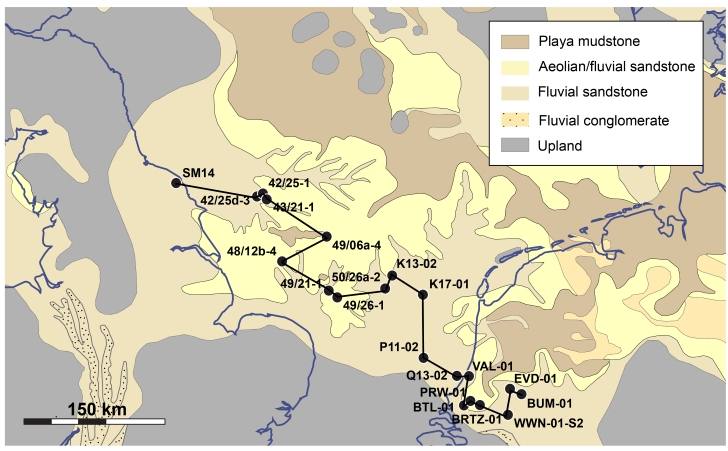Cyclostratigraphy of the Early to Middle Triassic of the Southern North Sea (CASP.BSSC.3)
This project and its resultant report present a high-resolution cyclostratigraphic analysis of the Lower Triassic reservoir interval in the UK and Dutch sectors of the Southern North Sea. We applied time-series (spectral) analysis to gamma-ray logs from 20 wells, confirming the presence of long- and short eccentricity (c. 405 kyr and c. 100 kyr) cycles and documenting their sedimentological expression and regional distribution. By integrating this with core sedimentology and XRF geochemistry, a new high-resolution framework is established for correlation and prediction of reservoir architecture and compartmentalisation. The results offer new insights into facies distribution and porosity–permeability trends, supporting stratigraphic de-risking for geological carbon storage (GCS) and reservoir appraisal.
Recognition of orbitally paced controls on sedimentation provides a powerful basis for understanding reservoir architecture. Prediction of high- and low-permeability intervals has implications for the management of CO₂ injectivity, plume migration, containment, pressure management and compartmentalisation. The near-isochronous nature of the cycles provides a chronostratigraphic foundation to enhance subsurface prediction and reduce stratigraphic uncertainty across the basin.

Delivery of data
The data are presented in a fully illustrated physical and electronic report (167 pages), which includes a detailed well correlation panel, well-by-well spectral analysis and summary tables. A supplementary package includes the StrataBugs project used for correlation (with band-pass–filtered long- and short-eccentricity curves and surface/cycle picks), the XRF dataset (1,498 measurements from four wells) and a GIS project of well locations.
Completed: October 2025
Report details: Cyclostratigraphy of the Lower Triassic, Southern North Sea Basin: implications for the Bunter Sandstone CO2 storage complex
For further information, including licensing details, contact: [email protected]
Products
- Geological Carbon Storage Research
- Mudrock Seals in CO2 Storage Systems Thematic Research
- Bunter Sandstone Storage Complex Thematic Research
- A palynozonation of the Bunter Sandstone CO2 storage complex: onshore analogue study (CASP.BSSC.1)
- Palynostratigraphy of the Bunter Sandstone CO2 storage complex in the Southern North Sea (CASP.BSSC.2)
- Cyclostratigraphy of the Early to Middle Triassic of the Southern North Sea (CASP.BSSC.3)
- Reservoir composition and diagenesis (CASP.BSSC.4)
- Controls on Bunter Sandstone composition (CASP.BSSC.5)
- Middle Triassic seals – onshore analogue study (CASP.BSSC.6)
- Middle Triassic seals – UK and Dutch offshore wells study (CASP.BSSC.7)
- Reactions and Flow of CO2 Fluid in Compositionally Immature Sandstones Thematic Research
- The Impact of Volcaniclastic Rocks on CO2 Storage Thematic Research
- Regional Research
- Reports
- Project History
- Data Packages
- Geological Collections and Data
